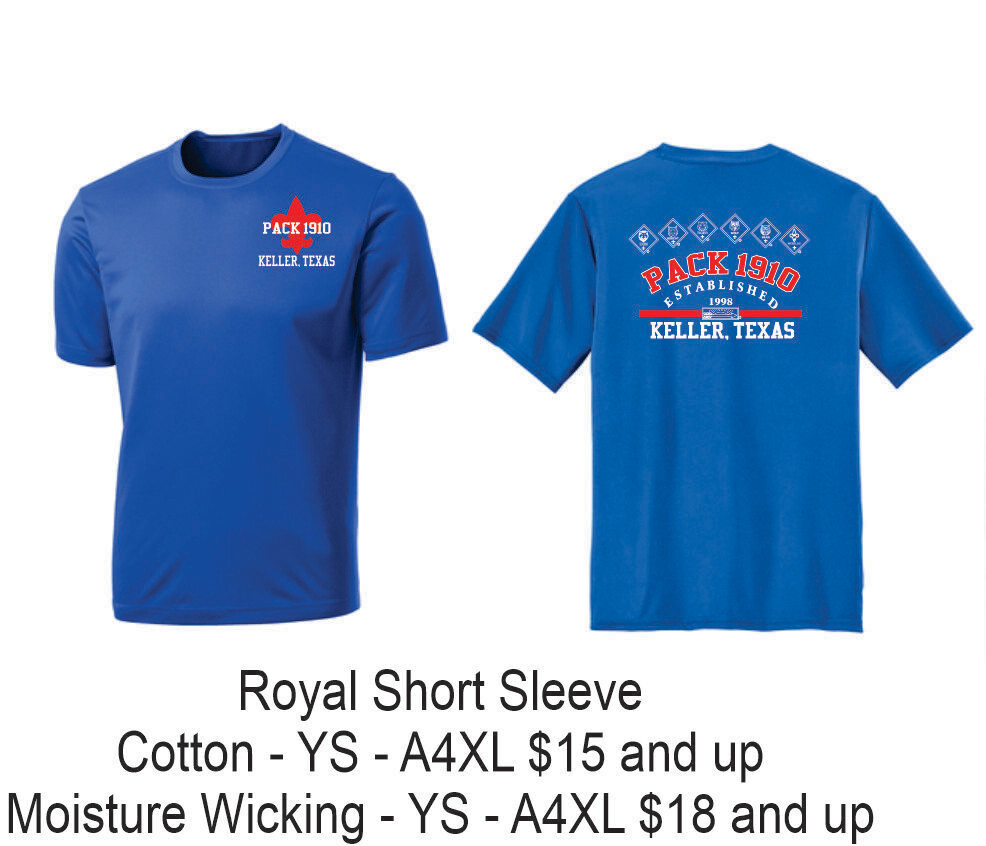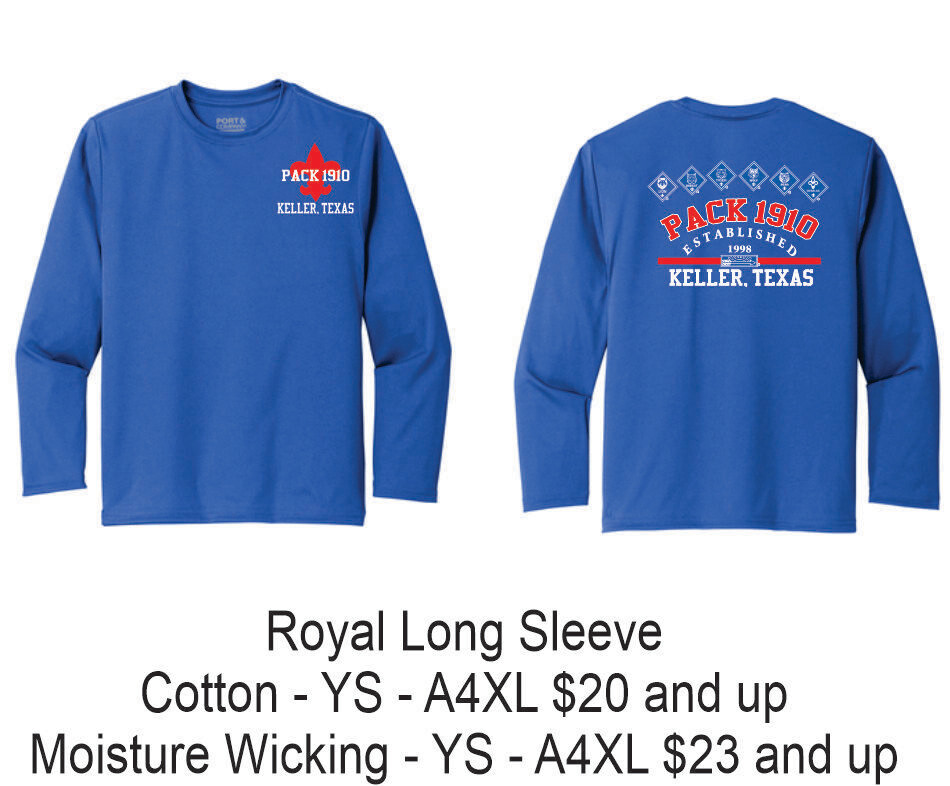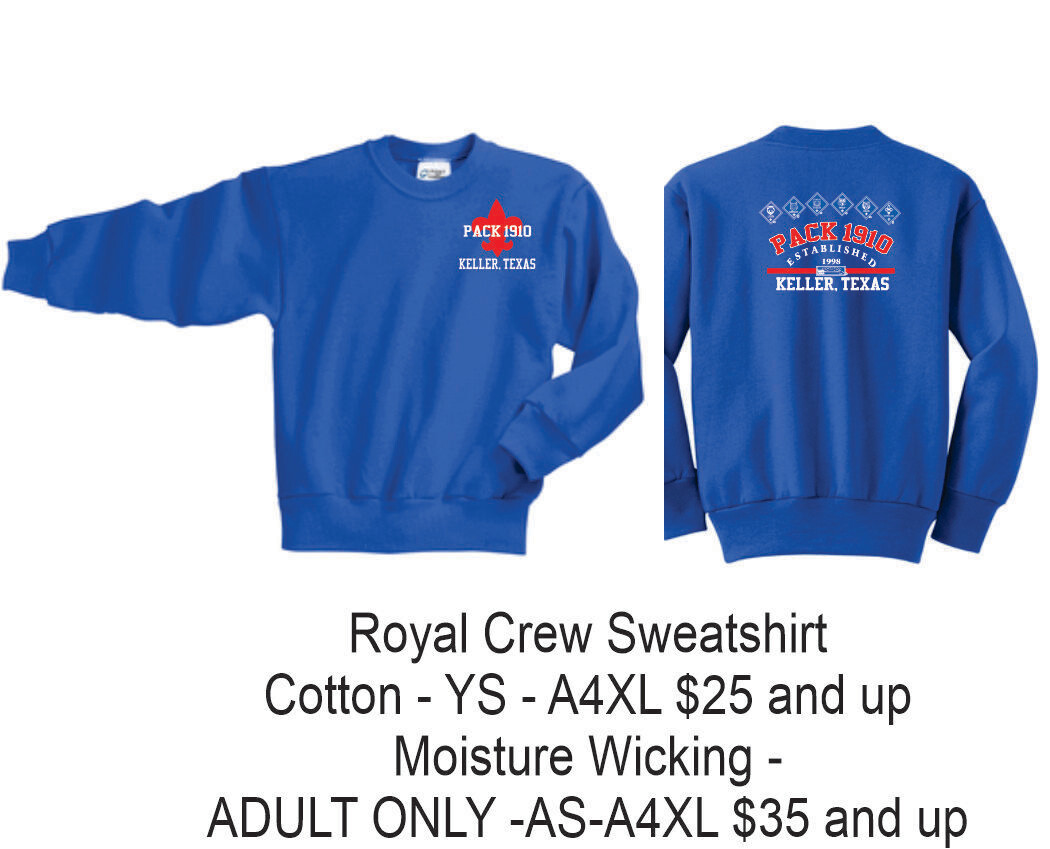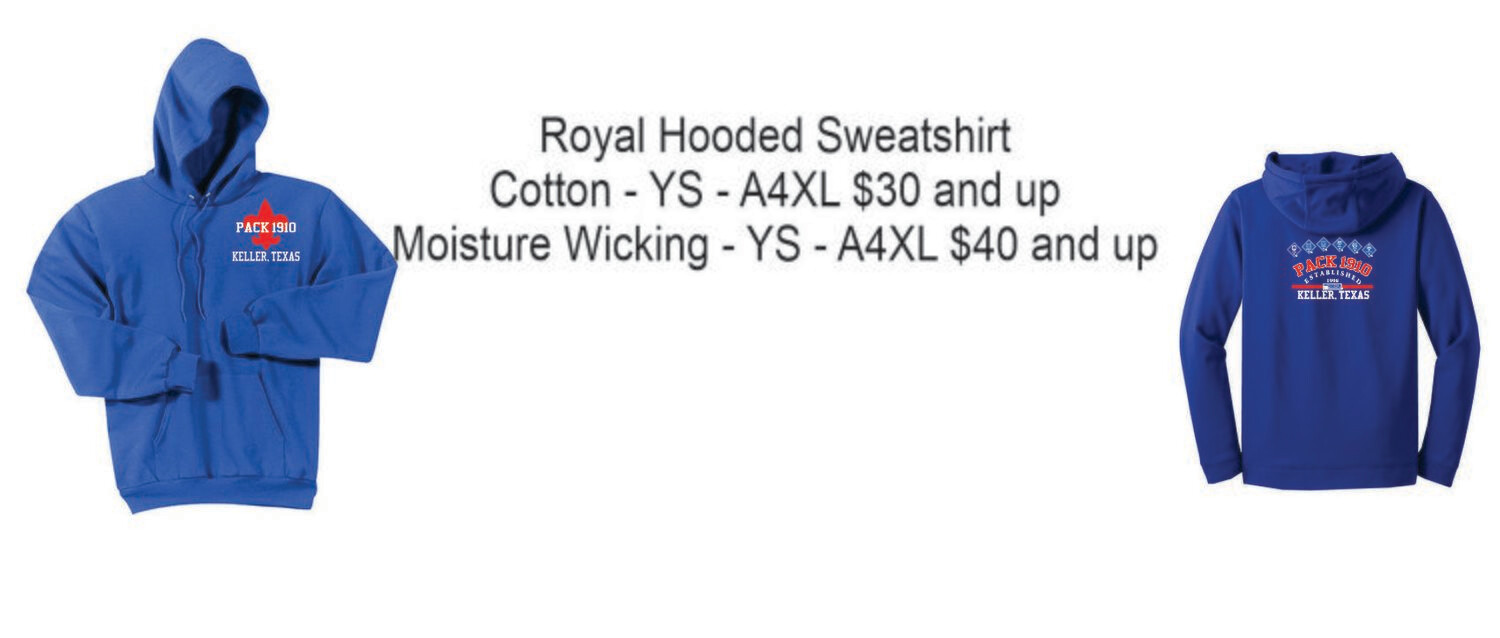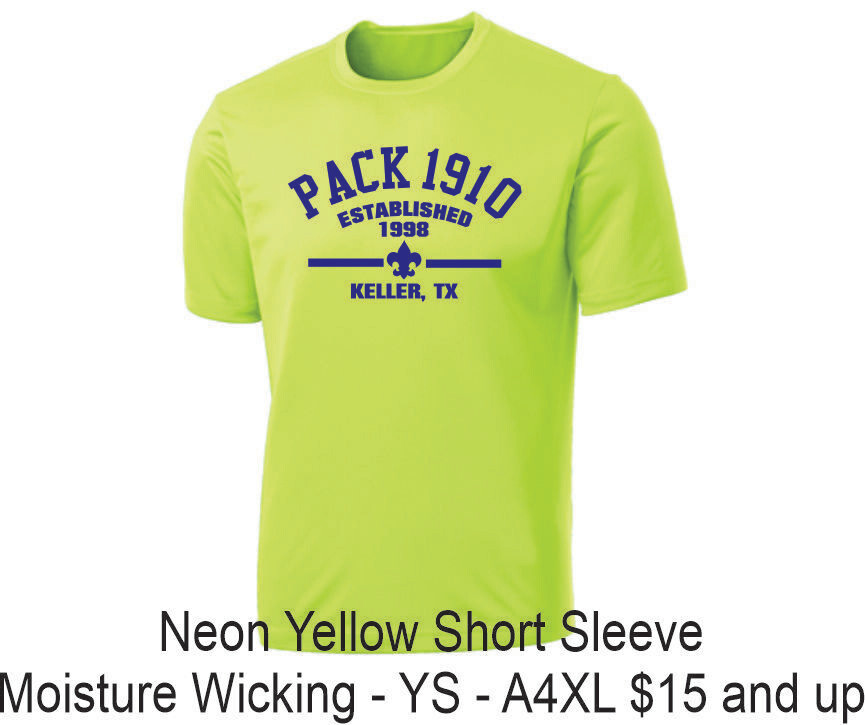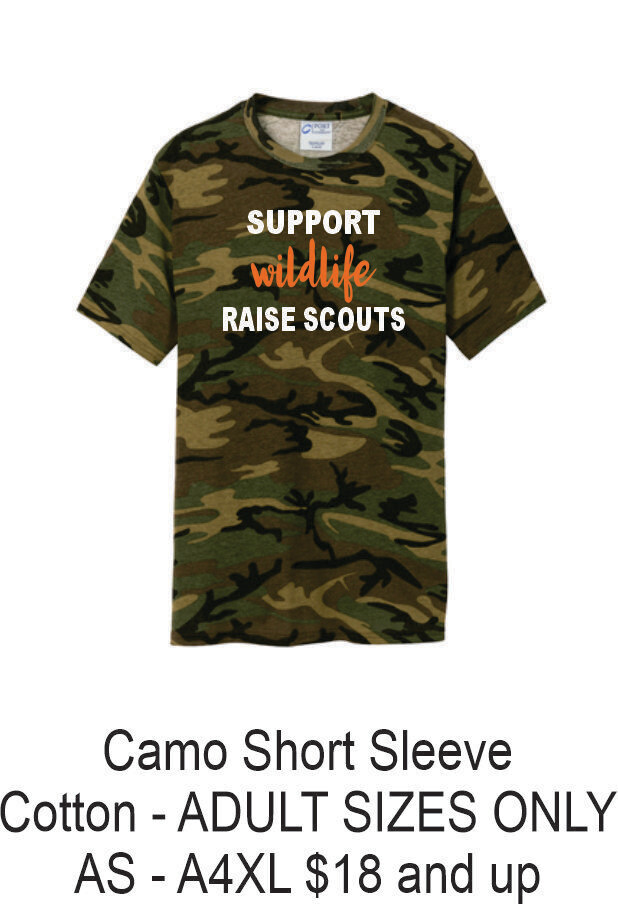Saturday, November 13, 2021
T-Shirts Orders are LIVE!
Friday, November 12, 2021
Recharter - Deadline December 1
It’s time again to recharter our Pack with the Boy Scouts of America (BSA). As part of this process, each Scout and registered leader must renew their membership for the upcoming year (which includes payment of registration dues and ensuring your Health Form (Part A and B) is current). While our Pack operates on a SCHOOL calendar of June - May, registration dues for everyone are paid on a January-December basis.
$150 without Scout Life magazine; or
$162.50 with Scout Life magazine
Leaders are $60 and require a new Background Authorization Form
2) Longhorn Council Insurance Fee - This $15 fee is paid directly to the Longhorn Council for the period of January through December. The annual Longhorn Council Insurance Fees are paid annually, prorated monthly ($1.25 per month) from the month of joining.
3) Scout Life Magazine - $12 per Scout, prorated monthly ($1 per month). Boys' Life is the monthly magazine for the Boy Scouts of America. It’s a fantastic read that reinforces Scouting and the good family values that are part of our program. This is totally optional.
4) Pack Fees - $63 (about $5 per month) The Pack charges an annual Pack Fee to help cover the cost of running the Pack. This fee includes all program costs and is set each year by the Pack Committee. At the very basic level, this covers your scout's rank specific neckerchief slide and neckerchief at bridging each May, advancement, awards, badges, patches, pins, adventure loops, hiking awards, ceremony supplies, and the like. As you can see, there are a great deal of tangible goods that each scout receives annually just for doing what they do! This doesn't even begin to cover the other costs... just what our scouts receive.
Thus, we rely heavily on fundraising to ensure an awesome program for our youth. Simply stated, our Pack is POWERED BY SCOUTS and it will take us all to ensure we can have a successful fundraiser!
PLEASE do not make us chase you for filing your paperwork.
Without registration commitments, we cannot recharter you (as a registered leader) your Scout. Awards and rank cannot be recorded for unregistered Scouts.
While we try to streamline this as much as process, there IS paper involved -- we need a new health form for anyone that hasn't submitted one within the last year. We need completed YPT certificates for all parents with their Scouts if you have not supplied those via e-mail. All leaders must be trained for their positions prior to recharter. All registered leaders need to have their YPT renewed THIS YEAR.
Thank you for your assistance in making this as painless and streamlined of a process as possible. I appreciate everyone's prompt attention to this matter. If you have any questions at all, please do not hesitate to contact Alison Ford who handles all things Membership.
Thursday, November 11, 2021
Scout Salute to our Veterans
Scouting has a history rich in military service as well. Robert Baden-Powell, the father of Boy Scouts, was a British officer with a long military career. Much he learned along the way in his military career directly correlated with how he established scouting. As it stands, many of our current military academies are home to a considerable amount of Scouts - over 1/3 of the cadets at West Point were involved in scouts and 16% are eagles; over 20% of the Air Force cadets were in scouting and 12% are Eagles; and 25% of the Naval Academy midshipmen were in Scouts and 11% are Eagle Scouts. Though it's not the only way, it's definitely a great path to being a part of something much bigger than yourself.
So, today, we humbly give thanks to those who have signed their name on the line and said, "Whatever it takes... I'm here for America." Those are the kind of courageous men and women we honor today.
Some interesting facts from History.com about veterans:
The brave men and women who serve and protect the U.S. come from all walks of life; they are parents, children and grandparents. They are friends, neighbors and coworkers, and an important part of their communities. Here are some facts about the current veteran population of the United States.
There are approximately 21 million military veterans in the United States.
- 16.1 million living veterans served during at least one war.
- 5.2 million veterans served in peacetime.
- 2 million veterans are women.
- 7 million veterans served during the Vietnam War era (1964-1975).
- 5.5 million veterans served during the Gulf War (representing service from Aug. 2, 1990, to present).
- Of the 16 million Americans who served during World War II (1941-1945), about 620,000 are still alive.
- 2 million veterans served during the Korean War (1950-1953).
- 6 million veterans served in peacetime.
- As of 2014, 2.9 million veterans received compensation for service-connected disabilities.
- As of 2014, 3 states have more than 1 million veterans in among their population: California (1.8 million), Florida (1.6 million), Texas (1.7 million).
- The VA health care system had 54 hospitals in 1930, since then it has expanded to include 171 medical centers; more than 350 outpatient, community, and outreach clinics; 126 nursing home care units; and 35 live-in care facilities for injured or disabled vets.
We remember your sacrifice. We honor your patriotism. To quote President Coolidge, "The Nation which forgets its defenders will be itself forgotten.”
Monday, November 8, 2021
Coat Drive Turn in TOMORROW
Friday, October 29, 2021
Every Scout Deserves a Well-Trained Leader
If you are new to Scouting, new in a particular Scouting volunteer position, or perhaps you want to step up to offer assistance in a supporting role, the University of Scouting will have courses offered for just about everything under the sun from the basics to becoming an Eagle mentor.
Saturday, November 20 is the Longhorn Council's University of Scouting. If you haven't registered, there is still time to pick your courses and make a day of it. Check out the Event Guide HERE
Early bird pricing ($25) for registration ends October 31.
(While walk-in registrations are allowed at a higher price point please consider the logistical nightmare for your volunteers who are teaching... they're busy preparing materials, handouts and such. The courtesy of an advance registration allows them to do their job and ensure enough materials are available for those in attendance. Pre-registration is just the kind thing to do. A Scout is kind. Register in advance. Thankyouverymuch.)
Check in is from 8a-9a
Classes begin at 9a and last until 12p
Lunch is from 12p-1p at the TCC cafeteria (not included in registration. You may bring your own or buy something there)
Afternoon classes are 1p-4p
Closing ceremony
Wednesday, October 20, 2021
A Scout is Brave
Bravery could mean something as simple as standing on top of the monkey bars to a Tiger scout or signing your name on the line to dedicate your life serving in our nation's military. Bravery can be conquering Mt. Everest or having the courage to stand up before strangers to deliver a speech. It could be going away for the first time ever to camp without the creature comforts to which you've grown accustomed... to walking into the meeting of a brand new Pack and trying to make friends with people you don't know.
Bravery is saying no to the wrong thing.
Bravery can be having the courage to quit when you know the path by which you travel is not the one you intended. Listening to that inner voice rather than the masses of people that you may have surrounded yourself with.. is very brave.
Being okay with being different... is brave.

Bravery is... showing up... in every sense of the word.
{I do have to put a disclaimer here though -- don't let me allow ANYONE to confuse being brave with being stupid because the internet is FULL of people doing really, REALLY stupid things that don't equate to an OUNCE of bravery.}
Thanks, I feel better now.
Every month in the Scout's Life magazine there is a feature called Scouts In Action. Many of their stories highlight scouts all over the world who showed bravery. Check out some of those stories the next time it arrives in your mailbox. In fact, here's a link to the site with the previously published Scouts in Action pages from the magazine. If you want to receive this magazine at your home, you can for $12 with your recharter.
So taking on the idea of bravery... did you know that a Scout can face danger even if they are afraid... that's being brave. Think of all the things people are afraid of. I'll bet that one of the top fears on more lists than you could even fathom is...
There are lots of people who believe that the only good snake is a dead snake but there couldn't be anything further from the truth. Snakes are beneficial to our ecosystem in more ways than you can imagine. The way to learn to be brave if you're afraid of them is by educating yourself to identify the venomous snakes you might come across so that when you see anything other, you can simply appreciate them (and... perhaps spray them with a water hose to get them to go away if you're still not a fan).
Shaun Hayes has one of my favorite Instagram accounts @tx_snakewrangler and he has given me permission to use his photos for this post. They're beautiful and amazing and I'm so grateful for his love of herping which enables me to share with you ways to identify these creatures. Because, the more you know...the more you grow! Please check him out on YouTube too right here.
Coral Snake
- Coral snakes have one of the strongest venoms of any snake, but because of their small jaws they are not considered as dangerous as rattlesnakes.
- The snakes are usually between 18 and 20 inches long. Some grow to be 3 feet long.
- They can be as skinny as a pencil.
- Their heads are small and look like their tails.
- Their fangs are always out because they cannot pull them back into their mouths.
- There is a harmless king snake that looks so much like the coral snake that people made up a rhyme about their coloring. However, it is a good idea to never pick up any snake unless there is an adult with you. The rhyme is: “Red and yellow, kill a fellow; “Red and black, just stay back.” So, if the red bands touch the yellow bands, you know it's a coral snake.
- Coral snakes live in a variety of habitats, ranging from marshes to woods and sand hills. They also like to sleep under rotting leaves. They are often found in suburban areas as well.
- They eat lizards and other small snakes.
- They lay eggs. Babies are 7 inches long when they hatch and are fully venomous.
- Most people who are bitten receive the bite when they pick up the snakes or step on them with bare feet.
 |
| Here is a photo of a coral snake. See if you can find the head. See how the red touches yellow? |
Copperhead
- Copperhead snakes get their name from their copper-red heads.
- They are pit vipers and have heat-sensing pits on their faces that help them detect prey.
- Copperheads have wide, muscular bodies with hourglass-shaped markings.
- They average between 2 and 3 feet long.
- They live in many different environments, including rocky areas, woods, and mountains; near streams, desert oases, and canyons. Nearer to humans, they also love to live in wood and sawdust piles, abandoned and overgrown yards, and old construction areas.
- Although they hunt alone, they are social and hibernate in dens with many other snakes.
- Copperheads eat mice and other small rodents, small birds, lizards, amphibians, small snakes, and insects.
- They use their pits to sense heat and track prey. After they bite large prey, they wait until the prey dies and then eat it.
- Adults sometimes eat only 10 to 12 meals a year if the meal is a larger animal.
- Babies are born live with fangs and venom as dangerous as an adult snake’s.
- Copperheads give no warning and will strike almost immediately if they feel threatened.
 |
| See how the pattern looks like Hershey Kisses? That's a characteristic indicative of one species of copperhead. |
 |
| This is a broad banded copperhead. |
 |
| Another view of a copperhead. |
Rattlesnake
- A rattlesnake’s warning sounds are hissing and rattling of its tail.
- Rattlers can grow to be 1 to 7 feet long.
- They have a distinctly triangular head.
- Every time a rattlesnake sheds its skin, another ring is added to the rattle on its tail.
- Rattlesnakes live in many different environments in North and South America. They can live anywhere from desert sands to grasslands, scrub brush, rocky hills, and swamps. They can live in high elevations, up to 11,000 feet.
- Texas has NINE native species of rattlers. I've only seen four in my life.
- Generations of rattlesnakes can use the same dens for hundreds of years.
- They give birth every two years to live babies.
- They can live up to 30 years.
- Rattlesnakes eat small rodents, reptiles, and insects.
- Their strike is extremely fast.
- They eat about every two weeks.
- Most rattlesnake strikes on humans happen when the snakes are stepped or sat upon.
 |
| This is a massasauga rattler. Distinctive by the rattle (shocker) and the Pac Man pattern. |
 |
| This is an Eastern Timber rattlesnake |
Cottonmouth a.k.a. Water mocassin
- Cottonmouths are the only venomous water snake in North America, but they are also happy soaking up the heat on land.
- They have a triangular head and a thick body.
- They are also commonly called water mocassins.
- They are called cottonmouths because they open their mouths wide when they are threatened. The inside of the mouth is white, like cotton.
- They are pit vipers.
- Cottonmouths range from 2 to 4 feet long.
- They have dark vertical lines by each nostril and pale snouts.
- They can be found in swamps, marshes, drainage ditches, ponds, lakes, and streams or sunning themselves on land nearby.
- They swim with their heads out of the water.
- They eat fish, birds, amphibians, lizards, baby alligators, turtles, small mammals, and other snakes.
- Babies are born live in litters of up to 20.
- When threatened, cottonmouths will coil up, open their mouths, and expose their fangs.
 |
Speaking of mimicry... I want to draw your attention to how these NON VENOMOUS snakes can flatten their heads to LOOK largely triangular (which people like to say is indicative of venomous snakes). Lots of snakes learn ways to appear big and bad so they're not messed with. Another reason to educate yourself.
 |
| This plain bellied watersnake is frequently confused with a cottonmouth. See the vertical bars along its mouth? That's another way to identify this harmless, nonvenomous species. |
And if just watching this gave you the heebie jeebies -- thanks for being brave and making it to the end!
Coat Drive
Pack members, please check your Scoutbook emails for a printable invitation for you to collect in your neighborhood.
Sunday, October 17, 2021
Camping Do's and Don'ts
- Practice setting up your tent before you get on the camping trip. Make sure it is complete and you know how to put it up. Of course we will help you but you don’t want to get out there to realize you don’t have stakes or poles!
- Plan on it getting colder than you think – you can always take off a layer or remove a blanket. Put a sheet inside your sleeping bag it keeps it clean inside and will give you a layer of warmth or a layer of cool.
- Bring rain gear – you never know what the weather will be
- Change clothes to sleep in. (will keep you from getting cold due to moisture in the fabric from the day and you never know what you have on your clothes that you are bringing into your tent…poison ivy)
- Always have a tarp under your tent. Make sure none of it sticks-out from the bottom of the tent or it will collect rain and make the inside of your tent wet.
- Allow your Scout to do as much of the work while camping as possible (help putting up the tent, carrying stuff, etc). THEY CAN DO IT!! And will be proud that they did it.
- Store food, candy, toothpaste in your car or animal proof container but NOT your tent. They can smell it!
- Maintain the buddy system & Youth Protection Training (YPT) at all times!
- Never sleep in a tent with a child who is not your own. – BSA rule
- No alcohol anywhere, anyhow, anytime. – BSA rule
- No smoking or tobacco products in sight of Cub Scouts. – BSA rule
- Never leave candy/chips or candy/chip wrappers or food of any kind in your tent or in your clothes in your tent. Animals can smell it. This includes toothpaste, open Gatorade and other soda cans, etc. If in doubt leave it in your car.
- Cub Scouts should not have/use knives in Tiger and Wolf ranks. Bears and higher ranks may only bring pocket knives if they have completed the “Whittling Chip” pocket knife achievement and have their Whittlin’ Chip card or badge on their person. No knives with a blade longer than the width of a child’s palm. – BSA rule.
- Avoid 100% cotton clothing…think wool or synthetics. Cotton stays damp and makes you feel cold.
- Leave behind the Nintendo DS, iPod, or other electronics/game systems. This is the opportunity to get away from all that. Besides, they could get damaged or lost. BSA insurance doesn't cover that!
- No precious toys/ jewelry – could get damaged or lost.
Friday, October 15, 2021
Adopt-A-Street Clean Up is TOMORROW
We are responsible for the one-mile stretch of Bourland Road between Keller Parkway and Johnson Road.
All of us working together makes it easy to do our part to continue to...
As a bonus, by participating in this community service event, many of our scouts will earn needed requirement components for their rank advancement -- Community Service and a pretty cool patch!
As always, park on at the medical complex at 100 Bourland Road. Plan to meet at 9:15 am. Our check in is at 9am at Bear Creek Park so we will have someone doing that and then meeting the group at 9:15 in the parking lot.
All participants are asked to wear CLOSED TOE SHOES and WORK GLOVES (if you have them). If you can bring a few extra large black trash bags, that would be quite helpful.
This is an all-hands-on-deck event. Families are welcome but please be mindful that the younger siblings that require constant eyes or one-on-one supervision should probably sit this one out. The more that come, the faster it goes but it's a great way to show our support for our city and to do our part to help where others have forgotten to Leave No Trace.
Pack Camping - What Do I Need?
You guys ready for CAMPING? Are you a little “camping-shy”? Don’t let it hold you back!! Do it for your Scout – they’ll love you for it!!
We've had a few families asking about what they need for Cub Scout camping. First things first, all adults attending need to be Youth Protection Trained and all campers (adults/youth/siblings) need to have a completed BSA Health Form Part A and B on file with our Membership Chair, Alison Ford.
The best thing to do when starting to acquire gear is to start small and simple so that you can discover exactly what your family needs... and grow from there. There are plenty of seasoned camping veterans in our pack that have gear to spare so don't hesitate to put the word out if you need to borrow something.
To begin simply, you need something to sleep IN, something to sleep ON, somewhere to sit, something to wear, personal toiletries. light and water.
(Oh... and toilet paper! Don't forget the toilet paper!)
Today we're starting with something to sleep IN.
If you bring kids, you generally need more space so you might consider sizing up to accommodate all the stuff. If you want to sleep on cots, you need to be sure you're taking into account the space they take up literally and figuratively. If you want an air mattress inside your tent, be sure you have room for your belongings as well.
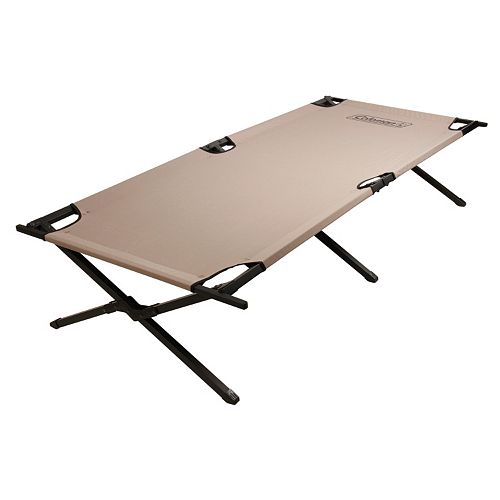 |
| One perk of cots is that you can generally store gear underneath allowing for more space in the tent to move about. Do note, however, that if you plan to sleep on anything other than a sleeping mat, adding air between you and the ground means it can get really chilly if the temps drop. So be prepared with extra insulation between you and the cot or air mattress. |
Do consider the bigger the tent, the more size it takes up in your vehicle and the more it weighs. Large tents that need to be heavily staked down may not be as conducive to allowing the Scouts the opportunity to help with set up. We've had several families in the past who brought two SMALLER tents rather than one large one. Since Cub Scout camping is "car camping" weight really shouldn't be an issue, however.
Once you've determined size, you'll need to determine what SHAPE of tent you want. You can get dome tents or cabin tents.
Dome tents are generally lighter, easier to set up and are much more stable in high wind conditions.

Cabin tents, however, provide more vertical space (if you're tall this might be a consideration so be sure to check the peak height listed) Some even have "rooms" where you can zip off walls (to help separate siblings who won't quit poking each other not that I have any idea what that is like.)
| This cabin tent even has a shaded vestibule which would be perfect for chairs. |

My suggestion is to go where you can get inside and test them out... Cabelas or Bass Pro both have tents set up in the store that you can check out. Seriously, get inside and lay down to see just how much space you actually have and then use those dimensions to help set a minimum allowance for what you want.
My only other suggestion for you to consider is to put SOME SORT of reflective SOMETHING on your guylines to prevent people from tripping over them in the dark. Accidents happen. Tent stakes through the leg are NO fun... we try to prevent the Scouts from running between tent lines but you know how well excited children listen. Reflective tape for your guylines - you want this!
This is going to be your home away from home. You want to be comfortable and to sleep as good as you can away from your Sleep Number Bed.
Another consideration is that once your Cub Scout transitions to Scouts BSA, usually the Troop will be providing the tent. If you want to come camping with the Troop, you'll want a SMALL tent since it will be just you and your gear. At that point, small is king!
Hope these will give you something to consider when starting to build your camping gear!
Camping Deadline is Today
Are you on the fence about our fall campout? Don't be! Camping is one of the best way to keep your Scouts EXCITED ABOUT CUB SCOUTS!
Camping is one of the main reasons kids have so much fun in Cub Scouts!
Why is Camping Important to the Boy Scouts of America?
In addition to the basics of survival and conservation, older Scouts instruct younger campers in the basics of wilderness training, plant science and perfecting a camp’s food storage plan. Essential skills are passed from generation to generation resulting in rewarding youth-led and adult-guided experiences.
At the Cub Scout level, camping has become an integral part of the advancement path so that the youth are prepared for the adventures of Scouts BSA. Speaking of our Troops, did you know that Scouts BSA can earn more than 136 merit badges, most of which involve outdoor experiences. Therefore, camping trips go a long way toward putting a Scout on the path toward Eagle.
The typical American’s first camping trip occurs before they reach 18 years old. The Physical Activity Council, an association of sports recreation and leisure activity companies, surveyed 10,778 Americans in early 2015. The survey asked 6 to 24-year-olds which of 104 activities they preferred. Respondents consistently choose camping and swimming.
Researchers discovered 28% of us did nothing last year! That’s right – 83 million are sedentary. Camping encourages us to be active and enjoy the outdoors resulting in three main benefits:
First, improved physical health
- We feel better – Oxygen emitted by plant life releases serotonin, a molecule essential to feelings of happiness and well-being. You can even lower blood pressure and body strain in the outdoors.
- Clean air and water – Lower levels of pollutants result in fewer lung irritations and illnesses.
- Greater physical fitness – Per hour calorie consumption increases for campers. Hikers burn 120-300 calories, fly fishers burn 200. Biking and swimming, gathering wood and building a temporary shelter results in healthy calorie burn and increased flexibility.
- Sunlight – Moderate sun exposure increases Vitamin D – essential for healthy bones and teeth.
- Natural food – Fishing and hunting provides nourishment without preservatives. And camp food just tastes better!
- Socialization – Improved mood from face-to-face interactions, teamwork and bonding without distractions.
- More Sleep – After a full day of outdoor activities, the body achieves more natural sleep when the sun goes down.
- Solving Problems – You can apply skills to overcome unexpected challenges and promote self-sufficiency by collaborating with your camping party.
- Discovery – Learn about plant science and build trust from working with domesticated animals such as horses and dogs. Be prepared to prevent insect bites and predator intrusions.
- Minding nature – The outdoors challenge you to minimize trash and leave your camping space cleaner than you found it.
Friday, October 1, 2021
Fall Camping Registration is LIVE!
One of the things all Scouts look forward to in Cub Scouts is CAMPING and it's almost time!
Make plans to join us for our fall Family Camp Out October 22-24.
Are you a little “camping-shy”? Don’t let it hold you back!! Do it for your Scout– they’ll love you for it!!
And, unless you have an open-ended bank account, don't run out and buy every piece of gear you think you need at REI (but if you just want to, please let me know and I'll give you my list, too!)
The best thing to do when starting to acquire gear is to start small and simple so that you can discover what your family needs... grow from there. There are plenty of seasoned camping veterans in our pack that have gear to spare so don't hesitate to put the word out if you need to borrow something.
To begin, you need something to sleep IN, something to sleep ON, something to wear, personal toiletries and light. (Oh... and toilet paper! Don't forget the toilet paper! That's definitely something you never want to not have and need.)
Cub Scout family camping is also referred to as "car camping." With a large enough vehicle, you're fortunate enough to be able to take just about everything AND the kitchen sink with you. But for the amount of time you'll be there, it's really not necessary. Though, a few creature comforts are definitely worth it!
Camping is definitely one of the highlights of any Cub Scout's year. Campouts are fun occasions where we get to come together as a Unit and we all have a blast. We have food and fun -- what more can you ask for?
Be sure to complete the registration link below by Friday, October 15, to ensure you are signed up for this event! Payment is due then as well.
